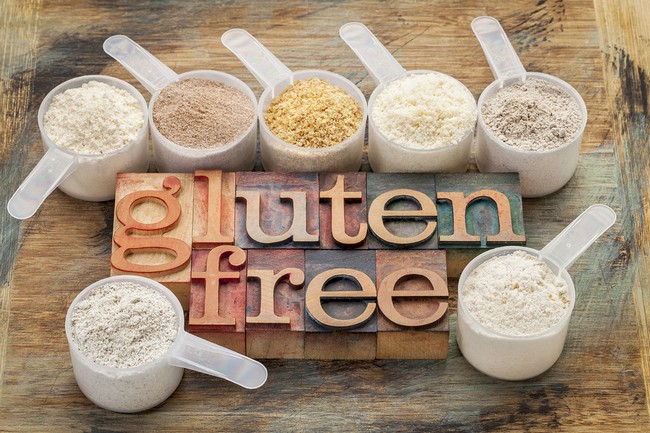- Make It Yourself Lavender Heart-Shaped Bath Bombs!
- 20 Things You Never Knew About “Down There”
- 12 Best Foods For Those Suffering From Arthritis Pain
- 12 Personal Hygiene Mistakes Almost Everyone Makes (Mom Never Told You About #4!)
- 15 Medicinal Plants And Herbs From The Cherokee People
- 12 Mind-Blowing Benefits Of Drinking Coconut Water During Pregnancy
- 12 Outstanding Winter Foods That Won’t Fatten You Up Like A Christmas Turkey
Avoiding Gluten? Use This Healthy Flour To Cook With Instead!

Photo credit: bigstock.com
If you are like many Americans, you are experimenting by cutting gluten out of your diet to see if it makes you feel better, or you already know that you have a gluten sensitivity, so you are always on the lookout for alternatives.
Coconut is one of the true miracle foods on this planet! Coconut oil, coconut milk, coconut water, and coconut flour are all super beneficial to our health. Although most people are well aware of the benefits of coconut oil, even coconut water, not nearly as many know about coconut flour.
Don’t confuse coconut flour with other types of wheat flours. It isn’t a grain at all. Coconut flour comes from the meat of fresh coconuts. After coconuts are pressed to remove the oil and milk, we have dried out, or dehydrated, coconut meat. This meat is then grated, resulting in a nice white almost powder-like substance that looks a great deal like white flour.
Now, this doesn’t mean that everything you cook with your coconut flour will end up tasting like coconut pie, but it does give foods a richer texture and a natural sweetness. This means you can use less sugar or honey in your baked goods!
Besides having wonderful flavor, this flour is super rich in nutrition. It is very high in fiber (48 percent of coconut flour is fiber!), it is a great source of protein, and it is super low in carbohydrates. This low level of carbs and high fiber content make this the perfect flour for diabetics, those who are insulin resistant, and those who are trying to lose weight.
Since coconuts contain lauric acid, you will also be getting plenty of antibacterial, anti-viral, and antiprotozoal compounds that support the immune system at the same time. This means that switching to coconut flour can prevent you from coming down with colds or the flu.
A few other reasons to switch to coconut flour, even if you don’t have sensitivity to gluten include:
- Improves Metabolism – One of the many health benefits of coconut flour is that, since it is high in medium chain fatty acids, your body can use this food for easy energy, it supports a healthy metabolism while it balanced blood sugar levels.
- Improves Digestive Health – Coconut flour has a high nutrient density, which helps the digestive process. The high fiber content also helps to keep moving things along in the colon.
- Heart Healthy – Studies have shown that coconut flour can lower the LDL (bad) cholesterol in the body. It can also lower serum triglycerides in those who have elevated cholesterol levels. This can help to keep the heart healthy and prevent cardiovascular disease.
The difference between coconut flour and regular wheat flour, the thing you should keep in mind is that a little bit goes a long way. You will need to adjust the amount you use for various recipes until you get the hang of it. First, try cutting the amount of flour in your recipe in half. If your mixture seems thinner than normal, add ¼ cup of coconut flour until you are satisfied with the texture.
Continue to Page 2

Photo credit: bigstock.com
What About Almond Flour?
It’s true that almond flour is loved for its versatility and gluten free qualities, but when compared to coconut flour, almond flour can’t hold a candle to it when it comes to fewer calories and more fiber. Also, if you are allergic to nuts, then coconut flour is the perfect choice!
Want to get started? You can buy coconut flour almost everywhere. If you have some on hand, we have a terrific gluten free banana bread recipe that you will love!
Gluten Free Banana Bread Recipe
Ingredients:
- 4 large very ripe bananas
- 4 whole eggs
- ¼ pound (4 ounces) of room temperature butter
- 1 cup of coconut flour
- ½ teaspoon of baking powder
- ½ teaspoon of baking soda
- 3 drops of French Vanilla stevia (or fresh stevia to taste)
- A dash of cinnamon
Instructions:
- Preheat your oven to 300 degrees.
- Liberally coat a glass baking pan with butter.
- In a large bowl, mix the eggs, butter, stevia, and bananas using a hand mixer.
- Add the coconut flour, baking powder, and baking soda. Mix again.
- Add the cinnamon and give it one last stir.
- If you like, you can add ¼ cup of walnuts or slivered almonds to the mix.
- Bake for 50 minutes at 300 degrees.
- Turn off the oven, but leave the bread inside for another 10 minutes.
An extra tip when it comes to buying coconut flour: Read labels and buy brands that list only coconut flour as their ingredient. Some companies add sugar, preservatives, or artificial flavors to their coconut flour. Buy only pure coconut flour for the best health.
READ ALSO: Top 15 Reasons Why You Might Want to Think Twice About Going Gluten Free
There are numerous ways to use coconut flour in your diet, even if you don’t like to bake! You can use it in place of breadcrumbs; make a gluten free coating for chicken or fish; add it to hamburger meat to give them more texture; even add some to soups or stews to make them thicker without having to rely on dairy products or wheat flour.
You are limited only by your imagination. Enjoy!
References:
































